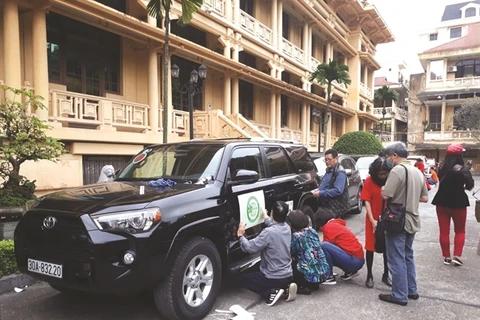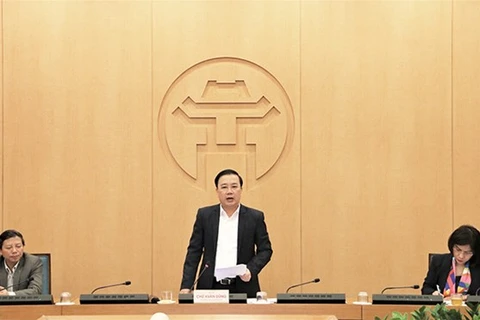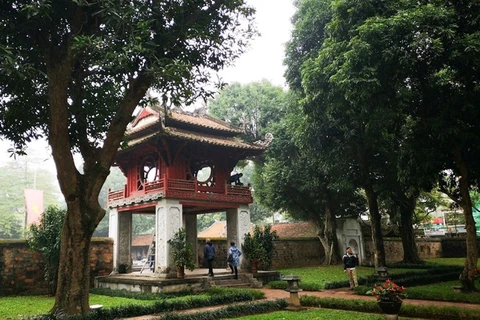Hanoi (VNA) - The Hanoi Department of Tourism has identified seven groups of tourism products to attract visitors to the capital as the latest resurgence of COVID-19 has been largely brought under control.
Heritage tourism will develop and perfect new tourism products for the Imperial Citadel of Thang Long, the Hoa Lo Prison relic site, the Temple of Literature, and Duong Lam Ancient Village, along with places of worship such as Huong Pagoda, the Tan Vien Son Thanh Temple complex, the Co Loa relic site, and Soc Temple.
Sightseeing, recreation, ecological, and craft village tourism will continue to be developed in localities with the necessary advantages, including the outlying districts of Ba Vi, Soc Son, Thuong Tin, and Dan Phuong, so as to diversify products and meet visitor demand.
Culinary tourism will be promoted in inner districts like Hoan Kiem, Tay Ho, Long Bien, and Bac Tu Liem, home to typical Hanoi dishes.
A greater selection of souvenirs for tourists will be developed, while more showrooms of products in the “One Commune, One Product” programme will be opened to encourage spending.
New products will be also offered for those who wish to experience high-end hotels and entertainment services at four- and five-star hotels.
Tourism products and services associated with the night-time economy will also be promoted, centring on Hoan Kiem district.
Local authorities will also facilitate adventure sports tourism and new entertainment activities such as hot air ballooning, mountaineering, and mountain biking at Ba Vi National Park.
Director of the Hanoi Department of Tourism Dang Huong Giang said Vietnam’s borders have been closed to international tourists since April last year. The number of foreign arrivals in Hanoi during this period was insignificant, and were mostly in Vietnam for work.
The resurgence of COVID-19 in late January discouraged many domestic travellers from visiting the capital, she said, adding that it welcomed just 1.93 million domestic visitors and earned some 5.4 trillion VND (234 million USD) in revenue during the first quarter, down 33.4 percent and 65.6 percent, respectively, year-on-year.
Hanoi will adopt various measures to attract 13.16-19.04 million tourist arrivals this year and will also make preparations for when Vietnam reopens its borders to international travellers, Giang said.
At a recent conference, experts and businesses contributed various measures and solutions to lure more visitors to the city.
Nguyen Le Huong, Deputy General Director of Vietravel held that in the current situation, the tourism sector should pay greater attention to the programme to encourage Vietnamese to travel Vietnam, and Hanoians to tour Hanoi.
She said the tourism potential of the capital city remains under-exploited, such as the beauty of outskirt districts and trade villages.
Agreeing with Huong, Truong Quoc Hung, President of the Hanoi UNESCO Travel Club said that the area of Ba Vi and Soc Son boast great potential for ecotourism as well as cultural, resort and sport tourism, which is suitable to families and groups of tourists. The city should also exploit its strength in spiritual tourism as well, he said.
Many experts asserted that Hanoi has yet to optimise its rich cultural tradition, advising the city to design more new, unique and typical tourism products of this type.
Phung Quang Thang, Director of Hanoi Tourist and President of the Hanoi Travel Association said that travel businesses should review and restructure their products to create more attractive tours.
Thang said that the firms should work more closely with local authorised agencies to focus on developing night tourism, citing statistics showing that 70 percent of people engaging in night tourism activities enjoy food, 20 percent often drink and 10 percent engage in entertainment activities. In his opinion, with its advantages in night tourism such as the two pedestrian areas of the Old Quarter around Hoan Kiem Lake and Trinh Cong Son Street near West Lake, Hanoi’s culinary tourism will help travel firms thrive./.
Heritage tourism will develop and perfect new tourism products for the Imperial Citadel of Thang Long, the Hoa Lo Prison relic site, the Temple of Literature, and Duong Lam Ancient Village, along with places of worship such as Huong Pagoda, the Tan Vien Son Thanh Temple complex, the Co Loa relic site, and Soc Temple.
Sightseeing, recreation, ecological, and craft village tourism will continue to be developed in localities with the necessary advantages, including the outlying districts of Ba Vi, Soc Son, Thuong Tin, and Dan Phuong, so as to diversify products and meet visitor demand.
Culinary tourism will be promoted in inner districts like Hoan Kiem, Tay Ho, Long Bien, and Bac Tu Liem, home to typical Hanoi dishes.
A greater selection of souvenirs for tourists will be developed, while more showrooms of products in the “One Commune, One Product” programme will be opened to encourage spending.
New products will be also offered for those who wish to experience high-end hotels and entertainment services at four- and five-star hotels.
Tourism products and services associated with the night-time economy will also be promoted, centring on Hoan Kiem district.
Local authorities will also facilitate adventure sports tourism and new entertainment activities such as hot air ballooning, mountaineering, and mountain biking at Ba Vi National Park.
Director of the Hanoi Department of Tourism Dang Huong Giang said Vietnam’s borders have been closed to international tourists since April last year. The number of foreign arrivals in Hanoi during this period was insignificant, and were mostly in Vietnam for work.
The resurgence of COVID-19 in late January discouraged many domestic travellers from visiting the capital, she said, adding that it welcomed just 1.93 million domestic visitors and earned some 5.4 trillion VND (234 million USD) in revenue during the first quarter, down 33.4 percent and 65.6 percent, respectively, year-on-year.
Hanoi will adopt various measures to attract 13.16-19.04 million tourist arrivals this year and will also make preparations for when Vietnam reopens its borders to international travellers, Giang said.
At a recent conference, experts and businesses contributed various measures and solutions to lure more visitors to the city.
Nguyen Le Huong, Deputy General Director of Vietravel held that in the current situation, the tourism sector should pay greater attention to the programme to encourage Vietnamese to travel Vietnam, and Hanoians to tour Hanoi.
She said the tourism potential of the capital city remains under-exploited, such as the beauty of outskirt districts and trade villages.
Agreeing with Huong, Truong Quoc Hung, President of the Hanoi UNESCO Travel Club said that the area of Ba Vi and Soc Son boast great potential for ecotourism as well as cultural, resort and sport tourism, which is suitable to families and groups of tourists. The city should also exploit its strength in spiritual tourism as well, he said.
Many experts asserted that Hanoi has yet to optimise its rich cultural tradition, advising the city to design more new, unique and typical tourism products of this type.
Phung Quang Thang, Director of Hanoi Tourist and President of the Hanoi Travel Association said that travel businesses should review and restructure their products to create more attractive tours.
Thang said that the firms should work more closely with local authorised agencies to focus on developing night tourism, citing statistics showing that 70 percent of people engaging in night tourism activities enjoy food, 20 percent often drink and 10 percent engage in entertainment activities. In his opinion, with its advantages in night tourism such as the two pedestrian areas of the Old Quarter around Hoan Kiem Lake and Trinh Cong Son Street near West Lake, Hanoi’s culinary tourism will help travel firms thrive./.
VNA
























